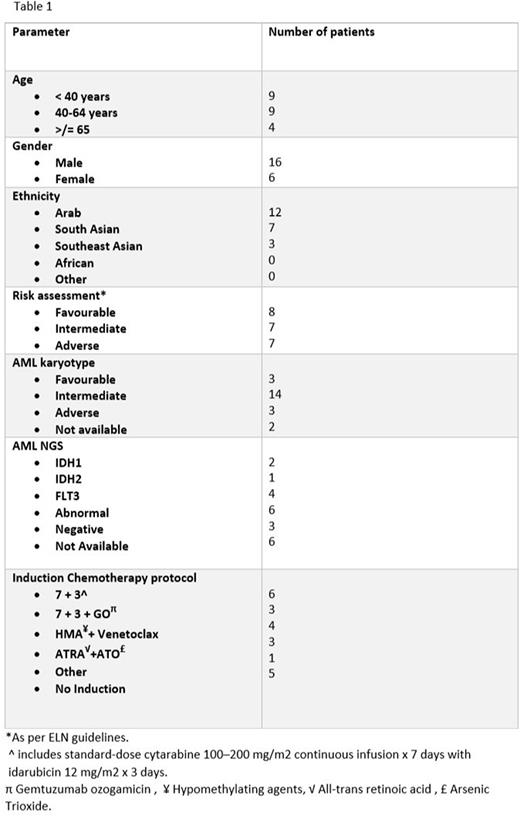Abstract
Population-based registries may provide data useful for clinical decisions in patients' populations not well presented by clinical studies, which is essential to establish recommendations for the management of patients in the real world.
The aim of the first Sheikh Shakhbout Medical City (SSMC) ongoing acute leukaemia registry is to obtain information about the demography, clinical presentation, genetic markers, risk stratification and disease response of patients with diverse ethnicities and backgrounds .The registry includes newly diagnosed adults with acute leukaemia, admitted to SSMC from June 2021 onward.
SSMC acute leukaemia registry is an observational retrospective and prospective study. Electrical medical records were used to collect data, and coding was used for each variable based on the 2017 European leukaemia network (ELN) and the 2016 European society for medical oncology (ESMO) clinical practice guidelines.
A total of 41 patients were registered between June 2021 and May 2022, 18 patients with acute myeloid leukaemia (AML), 3 acute promyelocytic leukaemia (APL) , and 1 blastic plasmacytoid dendritic cell neoplasm (BPDCN). Seventy three percent (n=16) of patients are males, and 27% (n=6) are females. Eighteen percent of patients (n=4) are older than 65 years of age, 2 of them with antecedent myelodysplastic syndrome. About 54% of patients are Arab, 32% are South Asian, and 14% are Southeast Asian (Table 1).
Forty percent of patients with normal karyotype which is close to previously reported percentage in Grimwade D et al, MRC AML 10 Trial. Blood 1998. Though our patients median age is 47 years at time of diagnosis, according to the 2017 ELN molecular stratification, about 32% of our patient group have adverse prognosis, which is higher compared to other clinical trials including the ones with older patients population (Grimwade D et al, MRC AML11 trial. Blood 2001).
Four patients are FLT3-ITD positive, accounts for 22% which is similar to the reported percentage in Papaemmanuil E et al, Genomic Classification and Prognosis in AML. N Engl J Med. 2016. Two patients are IDH1 positive, 1 patient is IDH2 positive, accounts for 5% compared to the reported 1% in Dohner H et al, Diagnosis and management of AML in adults. Blood. 2017 Jan. Seven patients have other abnormal Next generation sequencing (NGS) results, 2 patients have negative NGS and 6 patients have unknown cytogenetic risk group.
Induction chemotherapy includes standard-dose cytarabine 100-200 mg/m2 continuous infusion x 7 days with idarubicin 12 mg/m2 x 3 days in 33% of patients with AML, single dose of gemtuzumab ozogamicin 3 mg/m2 in addition to standard-dose cytarabine 200 mg/m2 continuous infusion x 7 days with daunorubicin 60 mg/m2 x 3 days in 17% of patients, hypomethylating agents with or without venetoclax in 22% of patients, and 28% of patients were not treated for various reasons including death and refusal of treatment.
The 3 patients with APL are low-risk (WBC count ≤10,000/mcL) as per Sanz MA et al, Management of APL. Blood. 2019 . All treated with all-trans retinoic acid (ATRA) 45 mg/m2 in two divided doses daily and arsenic trioxide (ATO) 0.15 mg/kg IV daily. The patient with BPDCN was treated with hyperfractionated cyclophosphamide, vincristine, doxorubicin, dexamethasone, alternating with high-dose methotrexate and cytarabine.
About 43% of patients achieved complete response (CR) or CR with incomplete hematologic recovery (CRi) post-induction as per the 2017 ELN guidelines.
SSMC is one of the leukaemia centres in Abu Dhabi, United Arab Emirates (UAE), where petroleum and natural gas are the main industry. UAE population consists of mixed ethnicities with different socioeconomic backgrounds where consanguinity is common and air pollution exposure at home countries is a big possibility.
Despite the fact that our patient population is small, and statistically significant analysis might not be possible at this stage, we believe that our patient population demographics and genetic markers are not well-reflected in the standard guidelines. With longer observation and time the SSMC acute leukaemia registry promises to provide interesting data that may shed important input for better treatment algorithms.
Disclosures
No relevant conflicts of interest to declare.
Author notes
Asterisk with author names denotes non-ASH members.


